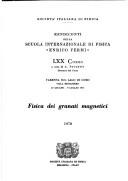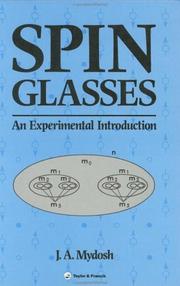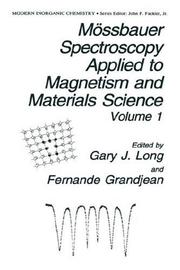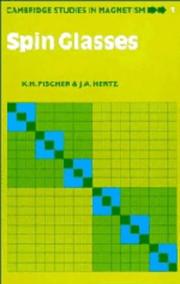| Listing 1 - 10 of 11 | << page >> |
Sort by
|
Book
ISBN: 0306683253 1468413988 1468413961 Year: 1972 Volume: v. 5 Publisher: New York, NY : Plenum Press,
Abstract | Keywords | Export | Availability | Bookmark
 Loading...
Loading...Choose an application
- Reference Manager
- EndNote
- RefWorks (Direct export to RefWorks)
Magnetic materials --- Bibliography --- 537.622 --- -Materials --- Magnetic properties of materials --- Bibliography. --- -Magnetic properties of materials --- 537.622 Magnetic properties of materials --- -537.622 Magnetic properties of materials --- Materials
Book
ISBN: 0471849855 9780471849858 Year: 1969 Publisher: New York, NY : John Wiley,
Abstract | Keywords | Export | Availability | Bookmark
 Loading...
Loading...Choose an application
- Reference Manager
- EndNote
- RefWorks (Direct export to RefWorks)

ISBN: 044485200X Year: 1978 Publisher: Bologna : Societa italiana di fisica,
Abstract | Keywords | Export | Availability | Bookmark
 Loading...
Loading...Choose an application
- Reference Manager
- EndNote
- RefWorks (Direct export to RefWorks)
Book
ISBN: 0198520271 Year: 1991 Publisher: Oxford [etc.] : Oxford University Press,
Abstract | Keywords | Export | Availability | Bookmark
 Loading...
Loading...Choose an application
- Reference Manager
- EndNote
- RefWorks (Direct export to RefWorks)
537.622 --- Nuclear magnetism --- -Rare earth metals --- -Lanthanide series --- Lanthanides --- Lanthanoid series --- Lanthanons --- Rare earth elements --- Nonferrous metals --- Magnetism --- Nuclear physics --- Magnetic properties of materials --- Congresses --- Magnetic properties --- -Congresses --- Rare earth metals --- Congresses. --- -Magnetic properties of materials --- 537.622 Magnetic properties of materials --- -537.622 Magnetic properties of materials --- Lanthanide series --- Magnetic properties&delete&

ISBN: 0748400389 9780748400386 Year: 1993 Publisher: London Taylor and Francis
Abstract | Keywords | Export | Availability | Bookmark
 Loading...
Loading...Choose an application
- Reference Manager
- EndNote
- RefWorks (Direct export to RefWorks)
Spin glasses --- Verres de spin --- 537.622 --- Glasses, Magnetic --- Glasses, Spin --- Magnetic glasses --- Magnetic alloys --- Nuclear spin --- Solid state physics --- Magnetic properties of materials --- Spin glasses. --- 537.622 Magnetic properties of materials
Book
ISBN: 0444851623 Year: 1978 Publisher: Amsterdam : Elsevier North-Holland,
Abstract | Keywords | Export | Availability | Bookmark
 Loading...
Loading...Choose an application
- Reference Manager
- EndNote
- RefWorks (Direct export to RefWorks)
Magnetic alloys --- -Metallic oxides --- -537.622 <063> --- Metal oxides --- Metals --- Oxides --- Alloys --- Magnetic materials --- Congresses --- Magnetic properties of materials--Congressen --- 537.622 <063> Magnetic properties of materials--Congressen --- Metallic oxides --- 537.622 <063> --- Magnetic properties. --- Oxydes --- Solid-state

ISBN: 030644447X 1489924116 1489924094 9780306444470 Year: 1993 Publisher: New York (N.Y.): Plenum
Abstract | Keywords | Export | Availability | Bookmark
 Loading...
Loading...Choose an application
- Reference Manager
- EndNote
- RefWorks (Direct export to RefWorks)
Theoretical spectroscopy. Spectroscopic techniques --- fysicochemie --- Materials sciences --- Magnetic properties of solids --- Mossbauer spectroscopy --- Magnetism --- 537.622 --- Materials science --- Material science --- Physical sciences --- Mathematical physics --- Physics --- Electricity --- Magnetics --- Spectroscopy, Mössbauer --- Spectrum analysis --- Mössbauer effect --- Magnetic properties of materials --- 537.622 Magnetic properties of materials
Book
ISBN: 0792332997 940104130X 9401102953 9780792332992 Year: 1995 Volume: 281 Publisher: Dordrecht ; Boston : Kluwer Academic Publishers,
Abstract | Keywords | Export | Availability | Bookmark
 Loading...
Loading...Choose an application
- Reference Manager
- EndNote
- RefWorks (Direct export to RefWorks)
It is well known that the density of molecular hydrogen can be increased by compression and/or cooling, the ultimate limit in density being that of liquid hydrogen. It is less well known that hydrogen densities of twice that of liquid hydrogen can be obtained by intercalating hydrogen gas into metals. The explanation of this unusual paradox is that the absorption of molecular hydrogen, which in TiFe and LaNis is reversible and occurs at ambient temperature and pressure, involves the formation of hydrogen atoms at the surface of a metal. The adsorbed hydrogen atom then donates its electron to the metal conduction band and migrates into the metal as the much smaller proton. These protons are easily accomodated in interstitial sites in the metal lattice, and the resulting metal hydrides can be thought of as compounds formed by the reaction of hydrogen with metals, alloys, and intermetallic compounds. The practical applications of metal hydrides span a wide range of technologies, a range which may be subdivided on the basis of the hydride property on which the application is based. The capacity of the metal hydrides for hydrogen absorption is the basis for batteries as well as for hydrogen storage, gettering, and purification. The temperature-pressure characteristics of metal hydrides are the basis for hydrogen compressors, sensors, and actuators. The latent heat of the hydride formation is the basis for heat storage, heat pumps, and refrigerators.
Colloques --- Colloquia --- Fysica --- Physique --- Alloys --- Intermetallic compounds --- 538.91 --- 537.622 --- Structures, including transitions --- Magnetic properties of materials --- 537.622 Magnetic properties of materials --- 538.91 Structures, including transitions --- Alliages --- Composés intermétalliques --- Metals --- Metallic alloys --- Metallic composites --- Phase rule and equilibrium --- Amalgamation --- Microalloying --- Composés intermétalliques. --- Composés intermétalliques.
Multi
ISBN: 909003546X
Abstract | Keywords | Export | Availability | Bookmark
 Loading...
Loading...Choose an application
- Reference Manager
- EndNote
- RefWorks (Direct export to RefWorks)
537.622 --- 538.91 --- 541.571 <043> --- Magnetic properties of materials --- Structures, including transitions --- Principal bonds. Homopolar bonds. Covalent bonds. Covalency--Dissertaties --- Theses --- 541.571 <043> Principal bonds. Homopolar bonds. Covalent bonds. Covalency--Dissertaties --- 538.91 Structures, including transitions --- 537.622 Magnetic properties of materials

ISBN: 0521342961 9780521342964 0521447771 9780511628771 9780521447775 Year: 1990 Volume: 1 Publisher: Cambridge Cambridge University Press
Abstract | Keywords | Export | Availability | Bookmark
 Loading...
Loading...Choose an application
- Reference Manager
- EndNote
- RefWorks (Direct export to RefWorks)
Magnetische glazen --- Spin glasses --- Verres magnétiques --- Spin glasses. --- Verres de spin --- 537.622 --- Glasses, Magnetic --- Glasses, Spin --- Magnetic glasses --- Magnetic alloys --- Magnetic properties of materials --- 537.622 Magnetic properties of materials --- 536.75 --- Nuclear spin --- Solid state physics --- 536.75 Entropy. Statistical thermodynamics. Irreversible processes --- Entropy. Statistical thermodynamics. Irreversible processes --- Quantum mechanics. Quantumfield theory --- Glass --- Verres de spin. --- Matière condensée. --- Condensed matter.
| Listing 1 - 10 of 11 | << page >> |
Sort by
|

 Search
Search Feedback
Feedback About UniCat
About UniCat  Help
Help News
News